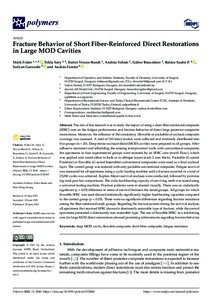| dc.contributor.author | Braunitzer Gábor | |
| dc.contributor.author | Vincze-Bandi Eszter | |
| dc.contributor.author | Forster András | |
| dc.contributor.author | Sáry Tekla | |
| dc.contributor.author | Garoushi Sufyan | |
| dc.contributor.author | Szabó Balázs P | |
| dc.contributor.author | Fráter Márk | |
| dc.contributor.author | Volom András | |
| dc.date.accessioned | 2022-10-28T14:21:25Z | |
| dc.date.available | 2022-10-28T14:21:25Z | |
| dc.identifier.uri | https://www.utupub.fi/handle/10024/170876 | |
| dc.description.abstract | <p>The aim of this research was to study the impact of using a short fiber-reinforced composite (SFRC) core on the fatigue performance and fracture behavior of direct large posterior composite restorations. Moreover, the influence of the consistency (flowable or packable) of occlusal composite coverage was assessed. A total of 100 intact molars were collected and randomly distributed into five groups (n = 20). Deep mesio-occlusal-distal (MOD) cavities were prepared in all groups. After adhesive treatment and rebuilding the missing interproximal walls with conventional composite, the specimens in four experimental groups were restored by an SFRC core (everX Flow), which was applied and cured either in bulk or in oblique layers (each 2 mm thick). Packable (G-aenial Posterior) or flowable (G-aenial Injectable) conventional composites were used as a final occlusal layer. The control group was restored with only packable conventional composite. Fatigue survival was measured for all specimens using a cyclic loading machine until a fracture occurred or a total of 25,000 cycles was achieved. Kaplan-Meyer survival analyses were conducted, followed by pairwise log-rank post hoc comparisons. The static load-bearing capacity of surviving teeth was tested using a universal testing machine. Fracture patterns were evaluated visually. There was no statistically significant (<em>p</em> > 0.05) difference in terms of survival between the tested groups. All groups for which flowable SFRC was used showed statistically significantly higher load-bearing capacities compared to the control group (<em>p</em> < 0.05). There were no significant differences regarding fracture resistance among the fiber-reinforced study groups. Regarding the fracture pattern during the survival analysis, all specimens that received SFRC showed a dominantly restorable type of fracture, while the control specimens presented a dominantly non-restorable type. The use of flowable SFRC as a reinforcing core for large MOD direct restorations showed promising achievements regarding fracture behavior.<br></p> | |
| dc.language.iso | en | |
| dc.title | Fracture behavior of short fiber-reinforced direct restorations in large MOD cavities | |
| dc.identifier.urn | URN:NBN:fi-fe2021093049037 | |
| dc.relation.volume | 13 | |
| dc.contributor.organization | fi=hammaslääketieteen laitos yhteiset|en=Institute of Dentistry| | |
| dc.contributor.organization-code | 2607500 | |
| dc.converis.publication-id | 59732457 | |
| dc.converis.url | https://research.utu.fi/converis/portal/Publication/59732457 | |
| dc.identifier.jour-issn | 2073-4360 | |
| dc.okm.affiliatedauthor | Garoushi, Sufyan | |
| dc.okm.discipline | 313 Hammaslääketieteet | fi_FI |
| dc.okm.discipline | 313 Dentistry | en_GB |
| dc.okm.internationalcopublication | international co-publication | |
| dc.okm.internationality | International publication | |
| dc.okm.type | Journal article | |
| dc.publisher.country | Switzerland | en_GB |
| dc.publisher.country | Sveitsi | fi_FI |
| dc.publisher.country-code | CH | |
| dc.relation.articlenumber | 2040 | |
| dc.relation.doi | 10.3390/polym13132040 | |
| dc.relation.ispartofjournal | Polymers | |
| dc.relation.issue | 13 | |
| dc.year.issued | 2021 | |
